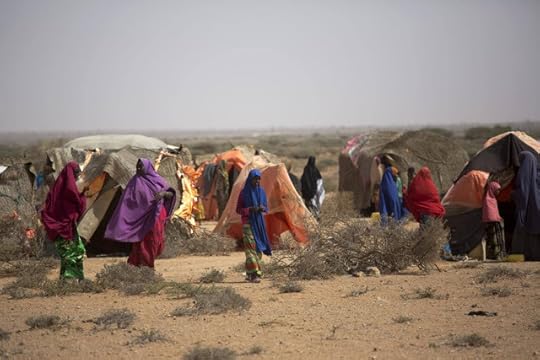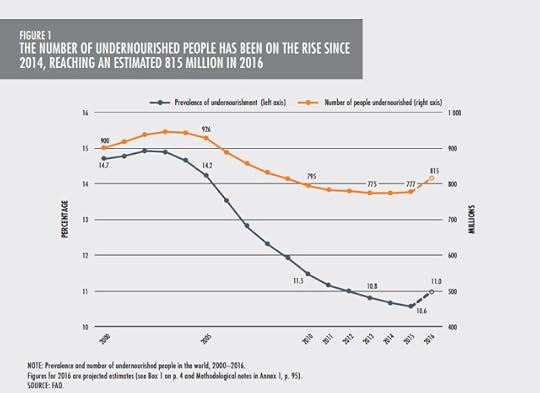Claude Forthomme's Blog, page 11
February 8, 2018
BITCOIN WORLD: WHAT NEXT?
I'm starting a series on cryptocurrencies, this is the first article, just published on Impakter:
ICOS: THE RISKS AND HOW TO ADDRESS THEM

Recent good news got lost in the midst of a flurry of bad news that shook the Bitcoin world at the end of January, causing a meltdown, with Bitcoin losing two-thirds of its value since hitting a peak of $20,000 in mid-December. Professor Roubini told Bloomberg that Bitcoin is “much worse than the Tulip mania”, that it’s the “mother of all bubbles”. At the time of writing, Bitcoin is still crashing, with no end in sight, though it is still significantly higher than the $900 value recorded a year ago (January 2017).
Among the avalanche of chilling events: the $530 million hack of Coincheck, a Japanese cryptocurrency exchange followed by a raid on the exchange by the Japanese authorities to check whether they had enough funds to repay customers; the Facebook ban on cryptocurrency ads; India’s Finance Minister declaration that cryptocurrencies would not be recognized as legal tender; the subpoena U.S. regulators sent to two of the world’s biggest cryptocurrency players, Bitfinex exchange and Tether, arousing suspicions of price manipulation; the announcement by major American banks (JP Morgan Chase, Bank of America and Citigroup) followed by a UK bank (Lloyds) that, starting in February, they would no longer allow their clients to purchase Bitcoin with credit cards; South Korea Customs Service’s disclosure of illegal Forex tradings of some $600 million worth of cryptocurrencies; North Korea accused of hacking cryptocurrencies and stealing billions of wons; the finding by a leading cyber security firm that hackers make on average $100 million a year stealing from “miners”.
And yet amongst the wreckage there was some optimistic news. One was the declaration on 31 January from the South Korea Finance Minister that there was no plan to outlaw digital coin trading, which countered an earlier ban announced by the Minister of Justice in September last year.
The other came from the South China Morning Post that announced on January 31 that the Hong Kong authorities would not ban cryptocurrencies but launch in March “a campaign to educate the public” highlighting that “cryptocurrencies have fluctuated in price, are not backed by any physical commodity or the issuer, and are subjected to hacking risks.” Leo Weese, chairman of the Hong Kong Bitcoin Association, is strongly supportive: “We should know the difference between what makes a good ICO [and what doesn’t]” he said, “and how we differentiate between scams and legitimate projects.”
He has good reason to feel this way: ICOs (Initial Coin Offerings) are the vital lymph of cryptocurrency exchanges and for them to function well, there needs to be trust in their legitimacy.
Read the rest on Impakter, click here.









ICOS: THE RISKS AND HOW TO ADDRESS THEM

Recent good news got lost in the midst of a flurry of bad news that shook the Bitcoin world at the end of January, causing a meltdown, with Bitcoin losing two-thirds of its value since hitting a peak of $20,000 in mid-December. Professor Roubini told Bloomberg that Bitcoin is “much worse than the Tulip mania”, that it’s the “mother of all bubbles”. At the time of writing, Bitcoin is still crashing, with no end in sight, though it is still significantly higher than the $900 value recorded a year ago (January 2017).
Among the avalanche of chilling events: the $530 million hack of Coincheck, a Japanese cryptocurrency exchange followed by a raid on the exchange by the Japanese authorities to check whether they had enough funds to repay customers; the Facebook ban on cryptocurrency ads; India’s Finance Minister declaration that cryptocurrencies would not be recognized as legal tender; the subpoena U.S. regulators sent to two of the world’s biggest cryptocurrency players, Bitfinex exchange and Tether, arousing suspicions of price manipulation; the announcement by major American banks (JP Morgan Chase, Bank of America and Citigroup) followed by a UK bank (Lloyds) that, starting in February, they would no longer allow their clients to purchase Bitcoin with credit cards; South Korea Customs Service’s disclosure of illegal Forex tradings of some $600 million worth of cryptocurrencies; North Korea accused of hacking cryptocurrencies and stealing billions of wons; the finding by a leading cyber security firm that hackers make on average $100 million a year stealing from “miners”.
And yet amongst the wreckage there was some optimistic news. One was the declaration on 31 January from the South Korea Finance Minister that there was no plan to outlaw digital coin trading, which countered an earlier ban announced by the Minister of Justice in September last year.
The other came from the South China Morning Post that announced on January 31 that the Hong Kong authorities would not ban cryptocurrencies but launch in March “a campaign to educate the public” highlighting that “cryptocurrencies have fluctuated in price, are not backed by any physical commodity or the issuer, and are subjected to hacking risks.” Leo Weese, chairman of the Hong Kong Bitcoin Association, is strongly supportive: “We should know the difference between what makes a good ICO [and what doesn’t]” he said, “and how we differentiate between scams and legitimate projects.”
He has good reason to feel this way: ICOs (Initial Coin Offerings) are the vital lymph of cryptocurrency exchanges and for them to function well, there needs to be trust in their legitimacy.
Read the rest on Impakter, click here.









Published on February 08, 2018 11:24
January 18, 2018
BITCOIN: THE FIRST DIGITAL PONZI SCHEME IN HISTORY

If you had invested $100 in Bitcoin in 2011, two years after it was invented, and if you had held onto it through the 2014 crash, when Mt. Gox, the biggest Bitcoin exchange, collapsed, today you’d have (almost) $4 million in your pocket.
That’s what the Winklevoss twins of Facebook fame and founders of the Gemini exchange did: They are, historically, the first believers and biggest investors in Bitcoin and today, now that they’ve turned bitcoin billionaires in 2017 (the only ones so far), they continue to believe in it, saying they won’t give it up, that “long-term, directionally, it’s a multi-trillion dollar asset”.
2017 was a special year. By December, the valuation of Bitcoin and the 700+ digital currencies that it has spawned had grown explosively, from less than $1,000 per bitcoin to over $15,000. 2018 is not looking so good, market cap is falling, but still high:

ON FOCUS: BY END 2017, TOTAL MARKET CAPITALIZATION (VALUE) OF ALL DIGITAL CURRENCIES EXCEEDED $ 750 BILLION, THOUGH IT IS NOW FALLING FAST AND STANDS WELL BELOW THAT VALUE (520 BILLION ON JANUARY 17, 2018) BUT STILL AT AN EXTRAORDINARY MULTIPLE (16 TIMES) OF WHERE IT WAS A YEAR AGO SOURCE: GLOBAL MARKET CAPITALIZATION CHART 28 APRIL 2013 TO 17 JANUARY 2018
On 17 January, Bloomberg spoke of a 26% slump noting that “traders brave the volatility” though some (rightly) worry about the growing threat from government regulations.
SO WHERE ARE WE GOING WITH BITCOIN?
To find out, read the rest on Impakter, click here.









Published on January 18, 2018 03:24
2017: The End of the American Century?
Just published on Impakter - in this article, I try to figure out where we're going, after the tsunami brought about by Trump. I am not optimistic but I'm not as pessimistic as some, as you'll see if you read the article to the end...Happy 2018, we need to continue the resistance, I'm convinced American leadership can be revived!
HOW AMERICA LOST WORLD LEADERSHIP

IN 2017, AMERICA ABRUPTLY CHANGED FACE. IT BECAME A DEEPLY DIVIDED COUNTRY NO LONGER INTERESTED IN WORLD LEADERSHIP. THE QUESTION IS: WHO WILL DOMINATE NEXT, CHINA, EUROPE, RUSSIA? OR IS AN AMERICAN RENAISSANCE POSSIBLE?Trump’s inaugural speech with its America First message shook the world. And he has kept it up with alarming tweets, insulting and threatening people and countries, sowing confusion among America’s allies and foes. His emotional and erratic tweeting may not add up to a credible foreign policy, he is, in his first year, the least popular President in US history and has signed fewer laws than Obama, yet, with support from the Republican Congress, he has brought deep change: He has successfully turned America in on itself and ushered an age of small government and Big Business.
American institutions are now in the hands of the Republican party. Control over the Supreme Court was achieved with Trump’s appointment of Judge Gorsuch and federal district courts are now filling up with young judges wedded to conservative views. Federal environmental protection regulations are dismantled, the coal and fuel industries can do as they please, the environment and public health be damned.
The tax overhaul benefits primarily the Republican party’s backers, big corporations and multi-millionaires. It also comes with a provision to drill for oil in the Arctic National Wildlife Refuge. And this on top of huge rollbacks in natural reserves, opening up to private exploitation over 2 million acres in Utah.
The only area that has resisted the Trump-Republican onslaught is Obamacare, but not for long. As Trump said at the GOP tax bill celebration, “we peeled Obamacare because we got rid of the individual mandate which was terrible” which is, as he clarified, “a primary source of funding of Obamacare”.
Clever. One can only hope that the Republican party will come up with a solution for the millions of Americans slated to lose coverage. So far, there is none on offer. Foreign observers (myself included) marvel that America has still not accepted the principle of free universal access to healthcare, first launched in Germany in 1883.
Read the rest on Impakter, click here.









HOW AMERICA LOST WORLD LEADERSHIP

IN 2017, AMERICA ABRUPTLY CHANGED FACE. IT BECAME A DEEPLY DIVIDED COUNTRY NO LONGER INTERESTED IN WORLD LEADERSHIP. THE QUESTION IS: WHO WILL DOMINATE NEXT, CHINA, EUROPE, RUSSIA? OR IS AN AMERICAN RENAISSANCE POSSIBLE?Trump’s inaugural speech with its America First message shook the world. And he has kept it up with alarming tweets, insulting and threatening people and countries, sowing confusion among America’s allies and foes. His emotional and erratic tweeting may not add up to a credible foreign policy, he is, in his first year, the least popular President in US history and has signed fewer laws than Obama, yet, with support from the Republican Congress, he has brought deep change: He has successfully turned America in on itself and ushered an age of small government and Big Business.
American institutions are now in the hands of the Republican party. Control over the Supreme Court was achieved with Trump’s appointment of Judge Gorsuch and federal district courts are now filling up with young judges wedded to conservative views. Federal environmental protection regulations are dismantled, the coal and fuel industries can do as they please, the environment and public health be damned.
The tax overhaul benefits primarily the Republican party’s backers, big corporations and multi-millionaires. It also comes with a provision to drill for oil in the Arctic National Wildlife Refuge. And this on top of huge rollbacks in natural reserves, opening up to private exploitation over 2 million acres in Utah.
The only area that has resisted the Trump-Republican onslaught is Obamacare, but not for long. As Trump said at the GOP tax bill celebration, “we peeled Obamacare because we got rid of the individual mandate which was terrible” which is, as he clarified, “a primary source of funding of Obamacare”.
Clever. One can only hope that the Republican party will come up with a solution for the millions of Americans slated to lose coverage. So far, there is none on offer. Foreign observers (myself included) marvel that America has still not accepted the principle of free universal access to healthcare, first launched in Germany in 1883.
Read the rest on Impakter, click here.









Published on January 18, 2018 03:11
November 27, 2017
I Support Net Neutrality!
Come and join me in this fight! Your freedom depends on it. Seriously. Read this excellent article written by my friend Hannah Fischer-Lauder - I am so happy to share it with you here, it's just published on Impakter
:
NET NEUTRALITY WAR: TRUMP WHITE HOUSE VS. SILICON VALLEY
by HANNAH FISCHER-LAUDER
On November 21, the new head of the Federal Communications Commission (FCC), Mr Ajit Pai, detonated a bomb on the Internet, announcing his plan to do away with net neutrality.
Why a bomb?
It’s very simple: eliminating net neutrality is a direct threat to consumers, start-ups and small businesses. A threat to all of us. It is the end of an open Internet. Anyone who cannot pay for access will be penalized.

IN THE PHOTO: INTERNET USER WITH A LAPTOP. PHOTO CREDIT: GLENN CARSTENS-PETERS ON UNSPLASH
DOES MR PAI CARE?
No, despite the avalanche of pro-net neutrality comments that flooded the FCC website when it called for comments (as it must, by law), he disregarded what real people had to say to him. I write “real people” because the FCC website got so messed up – hackers even attacked it in May – that, in the end, there were 22 million plus comments, most of them from bots.
Bots, fake comments on a government website? Yes, it’s not a joke. NY Attorney General Schneiderman on 21 November, in an open letter to the FCC Chairman, told him that in his estimation, hundreds of thousands of Americans’ identities were stolen and used in spam campaigns to support repealing net neutrality.
But there’s more.
Read the rest on Impakter, click here. Be sure to go to the end of the article, it gives you tips (and links) on what you can do to help in the fight against the FCC planned repeal of net neutrality regulations. And there's a lot you can do, sign petitions, write letters, share online.
Mr. Pai has scheduled the FCC vote on repeal for December 14. There is no time to lose!









NET NEUTRALITY WAR: TRUMP WHITE HOUSE VS. SILICON VALLEY
by HANNAH FISCHER-LAUDER
On November 21, the new head of the Federal Communications Commission (FCC), Mr Ajit Pai, detonated a bomb on the Internet, announcing his plan to do away with net neutrality.
Why a bomb?
It’s very simple: eliminating net neutrality is a direct threat to consumers, start-ups and small businesses. A threat to all of us. It is the end of an open Internet. Anyone who cannot pay for access will be penalized.

IN THE PHOTO: INTERNET USER WITH A LAPTOP. PHOTO CREDIT: GLENN CARSTENS-PETERS ON UNSPLASH
DOES MR PAI CARE?
No, despite the avalanche of pro-net neutrality comments that flooded the FCC website when it called for comments (as it must, by law), he disregarded what real people had to say to him. I write “real people” because the FCC website got so messed up – hackers even attacked it in May – that, in the end, there were 22 million plus comments, most of them from bots.
Bots, fake comments on a government website? Yes, it’s not a joke. NY Attorney General Schneiderman on 21 November, in an open letter to the FCC Chairman, told him that in his estimation, hundreds of thousands of Americans’ identities were stolen and used in spam campaigns to support repealing net neutrality.
But there’s more.
Read the rest on Impakter, click here. Be sure to go to the end of the article, it gives you tips (and links) on what you can do to help in the fight against the FCC planned repeal of net neutrality regulations. And there's a lot you can do, sign petitions, write letters, share online.
Mr. Pai has scheduled the FCC vote on repeal for December 14. There is no time to lose!









Published on November 27, 2017 03:43
November 23, 2017
DON’T BE EVIL: THE OTHER SIDE OF THE TECH INDUSTRY
Another one of my articles published on Impakter:
HOW TO ADDRESS THE TECH WORLD’S MORAL BLINDNESS

Who leads the tech world and what is their impact on the economy? Put together two remarkable statistics:
Of the ten richest men in America, only three are not tech billionaires: Warren Buffett and the Koch brothers;Tech firms represent 21% of the 500 largest American firms, yet they employ only 3% of the workforce (Guardian, 2017);
and you get an exact description of the New Golden Age.
We’ve moved from the Robber Barons of the 1900s to the tech billionaires of the 2000s. Same concentration of wealth, same political and economic power, same income inequality, same moral blindness – with one big difference that hurts the working class: compared to the Robber Barons and the manufacturing giants of the 1950s, they create very few jobs.
Worse: The ‘frightful fives’ – Apple, Google (Alphabet), Amazon, Microsoft and Facebook, as noted by the New York Times’ columnist Farhad Manjoo – are gobbling up start-ups, buying out the most successful rather than allowing healthy competition to develop. This puts the very process of innovation at risk. Instagram, WhatsApp, DeepMind are some of the better-known examples.
The rise of tech is affecting not just the economy, but our politics and culture too, twisting and straining the moral fibre of our society. In his 2016 speech at the Hiroshima Peace Memorial, Obama somberly noted that “technological progress without an equivalent progress in human institutions can doom us”. And he reminded us that “the scientific revolution that led to the splitting of the atom requires a moral revolution as well.”
The moral revolution certainly has not arrived in Trump’s America, focused for now on its America First agenda, denying climate change and trying to rebuild the coal-based manufacturing of the 1950s instead of addressing the real challenges of the future. Challenges that stem from tech industry AI products, robots and supercomputers, displacing jobs and ruining the middle and lower classes.
Tax havens are a big part of the story.
After the Panama Papers, we now have the scandal of another offshore firm, the Appleby files. Among Appleby’s long list of ultra-rich clients, including 31,000 Americans, we find a range of businessmen, pop stars and royals, including George Soros, the financier and philanthropist, Carl Icahn, the equity investor, Sheldon Adelson, the casino magnate, Madonna, Bono and even (for the first time) Queen Elizabeth II.
Inevitably, we find tech titans like Microsoft co-founder Paul G. Allen.
 IN THE PHOTO: FROM LEFT TO RIGHT, PAUL G. ALLEN, GEORGE SOROS, BONO AND QUEEN ELIZABETH. SOURCE: COLLAGE FROM PHOTOS IN WIKIMEDIA COMMONS
IN THE PHOTO: FROM LEFT TO RIGHT, PAUL G. ALLEN, GEORGE SOROS, BONO AND QUEEN ELIZABETH. SOURCE: COLLAGE FROM PHOTOS IN WIKIMEDIA COMMONS
While bashing the tech industry on moral grounds has become fashionable, how useful it is in curbing it is debatable. After all, the tech industry has changed our lives, sometimes for the worse, to be sure, but also for the better. And the industry has many friends and supporters, not to mention ample lobbying power both in Washington and Brussels. And so long as the industry is making money, criticism, however right and morally grounded, will fall on deaf ears.
There are other ways to curb the tech industry and ensure it becomes a responsible citizen.
To read the rest on Impakter, click here.









HOW TO ADDRESS THE TECH WORLD’S MORAL BLINDNESS

Who leads the tech world and what is their impact on the economy? Put together two remarkable statistics:
Of the ten richest men in America, only three are not tech billionaires: Warren Buffett and the Koch brothers;Tech firms represent 21% of the 500 largest American firms, yet they employ only 3% of the workforce (Guardian, 2017);
and you get an exact description of the New Golden Age.
We’ve moved from the Robber Barons of the 1900s to the tech billionaires of the 2000s. Same concentration of wealth, same political and economic power, same income inequality, same moral blindness – with one big difference that hurts the working class: compared to the Robber Barons and the manufacturing giants of the 1950s, they create very few jobs.
Worse: The ‘frightful fives’ – Apple, Google (Alphabet), Amazon, Microsoft and Facebook, as noted by the New York Times’ columnist Farhad Manjoo – are gobbling up start-ups, buying out the most successful rather than allowing healthy competition to develop. This puts the very process of innovation at risk. Instagram, WhatsApp, DeepMind are some of the better-known examples.
The rise of tech is affecting not just the economy, but our politics and culture too, twisting and straining the moral fibre of our society. In his 2016 speech at the Hiroshima Peace Memorial, Obama somberly noted that “technological progress without an equivalent progress in human institutions can doom us”. And he reminded us that “the scientific revolution that led to the splitting of the atom requires a moral revolution as well.”
The moral revolution certainly has not arrived in Trump’s America, focused for now on its America First agenda, denying climate change and trying to rebuild the coal-based manufacturing of the 1950s instead of addressing the real challenges of the future. Challenges that stem from tech industry AI products, robots and supercomputers, displacing jobs and ruining the middle and lower classes.
Tax havens are a big part of the story.
After the Panama Papers, we now have the scandal of another offshore firm, the Appleby files. Among Appleby’s long list of ultra-rich clients, including 31,000 Americans, we find a range of businessmen, pop stars and royals, including George Soros, the financier and philanthropist, Carl Icahn, the equity investor, Sheldon Adelson, the casino magnate, Madonna, Bono and even (for the first time) Queen Elizabeth II.
Inevitably, we find tech titans like Microsoft co-founder Paul G. Allen.
 IN THE PHOTO: FROM LEFT TO RIGHT, PAUL G. ALLEN, GEORGE SOROS, BONO AND QUEEN ELIZABETH. SOURCE: COLLAGE FROM PHOTOS IN WIKIMEDIA COMMONS
IN THE PHOTO: FROM LEFT TO RIGHT, PAUL G. ALLEN, GEORGE SOROS, BONO AND QUEEN ELIZABETH. SOURCE: COLLAGE FROM PHOTOS IN WIKIMEDIA COMMONSWhile bashing the tech industry on moral grounds has become fashionable, how useful it is in curbing it is debatable. After all, the tech industry has changed our lives, sometimes for the worse, to be sure, but also for the better. And the industry has many friends and supporters, not to mention ample lobbying power both in Washington and Brussels. And so long as the industry is making money, criticism, however right and morally grounded, will fall on deaf ears.
There are other ways to curb the tech industry and ensure it becomes a responsible citizen.
To read the rest on Impakter, click here.









Published on November 23, 2017 06:26
November 6, 2017
THE WORLD NUMBER ONE KILLER: NON-COMMUNICABLE DISEASES
Here's my latest article published on Impakter Magazine:

Non-communicable diseases are the major global health issue that most people have never heard of. Yet it kills nearly 40 million people every year, more than traffic accidents (1.3 million) or scary communicable disease outbreaks like Zika and Ebola that do make it in the news, but rarely exceed 10,000 deaths. For example, the 2014 Ebola outbreak in West Africa killed 11,310 (latest Centers for Disease Control data).
NCDs include four major diseases that you can’t catch from someone else:
cardio-vascular diseases (stroke and heart attacks, 48% of NCD deaths),cancer (21%),chronic respiratory diseases (12%),diabetes (3.5%).
This is not to belittle the threat or devastation caused by communicable diseases. Currently, the massive cholera outbreak in Yemen that has infected some 800,000 people in the past year and a plague outbreak in Madagascar that has killed nearly 100 people in two months are making the news. Rightly so, these are people in urgent need of help.
But NCDs should not be underestimated: They cause 70% of deaths globally, and nearly 50% of global disability. High-income countries are more affected than low-income countries (88% vs. 37%, 2015 data). As a result, there is a misperception that NCDs are a high-income country problem, but that’s not the case.
It’s a global problem.
And as I argue in the article, it's a global problem the World Health Organization (WHO) has been addressing over the past two decades...almost single-handedly. To find out what is being done, click here. This is an issue I feel very strongly about, and it's high time it be given the attention it deserves. The future of our children depends on it.










Non-communicable diseases are the major global health issue that most people have never heard of. Yet it kills nearly 40 million people every year, more than traffic accidents (1.3 million) or scary communicable disease outbreaks like Zika and Ebola that do make it in the news, but rarely exceed 10,000 deaths. For example, the 2014 Ebola outbreak in West Africa killed 11,310 (latest Centers for Disease Control data).
NCDs include four major diseases that you can’t catch from someone else:
cardio-vascular diseases (stroke and heart attacks, 48% of NCD deaths),cancer (21%),chronic respiratory diseases (12%),diabetes (3.5%).
This is not to belittle the threat or devastation caused by communicable diseases. Currently, the massive cholera outbreak in Yemen that has infected some 800,000 people in the past year and a plague outbreak in Madagascar that has killed nearly 100 people in two months are making the news. Rightly so, these are people in urgent need of help.
But NCDs should not be underestimated: They cause 70% of deaths globally, and nearly 50% of global disability. High-income countries are more affected than low-income countries (88% vs. 37%, 2015 data). As a result, there is a misperception that NCDs are a high-income country problem, but that’s not the case.
It’s a global problem.
And as I argue in the article, it's a global problem the World Health Organization (WHO) has been addressing over the past two decades...almost single-handedly. To find out what is being done, click here. This is an issue I feel very strongly about, and it's high time it be given the attention it deserves. The future of our children depends on it.









Published on November 06, 2017 07:59
October 26, 2017
COCAINE: THE HIDDEN COST - ENVIRONMENTAL DESTRUCTION (PART TWO)
This is the second of a two-part article investigating cocaine, just published on Impakter. Part One surveyed the cost in human terms, focusing on Colombia, the world’s top coca producer (see here). Part Two investigates the environmental destruction caused by cocaine and also takes a look at Peru.

Uncle Sam’s fumigation program in Colombia has added a grim dimension to the environmental devastation that is, in any case, inherent to coca production when it is made illegal. When coca fields are mechanically torn up by the army or the police, farmers are pushed deeper and deeper into the jungle to clear more areas to grow coca along with the food needed for their own sustenance.

IN THE PHOTO: RAINFOREST PHOTO SOURCE: ANAHI MARTINEZ ON UNSPLASHBut when coca fields are sprayed with potent herbicides, fumigation turns the fertile earth into a desert, threatening local farmers’ health. In fact, for decades, Colombia has been the only government in the world that has allowed aerial herbicide spraying of coca, hurting its own population. But it did so at the bidding of the United States that ended up paying US$ 2 billion for the spraying.
An extraordinary cost to the American taxpayers with zero results in terms of reduced cocaine supplies.
It had, however, very measurable results in terms of environmental destruction of Colombia’s rainforests – precious not just for Colombia but for the whole world, as they act as major carbon sinks, playing a key role in stabilizing global climate.
To read the rest, click here. I feel very strongly about the conclusion of the article: The solution, in my opinion, is not yet another "war on drugs" to try and limit cocaine supplies (it never works) but treatment to limit demand. Addicts are not children to be punished, they are people who need our help. Your views?










Uncle Sam’s fumigation program in Colombia has added a grim dimension to the environmental devastation that is, in any case, inherent to coca production when it is made illegal. When coca fields are mechanically torn up by the army or the police, farmers are pushed deeper and deeper into the jungle to clear more areas to grow coca along with the food needed for their own sustenance.

IN THE PHOTO: RAINFOREST PHOTO SOURCE: ANAHI MARTINEZ ON UNSPLASHBut when coca fields are sprayed with potent herbicides, fumigation turns the fertile earth into a desert, threatening local farmers’ health. In fact, for decades, Colombia has been the only government in the world that has allowed aerial herbicide spraying of coca, hurting its own population. But it did so at the bidding of the United States that ended up paying US$ 2 billion for the spraying.
An extraordinary cost to the American taxpayers with zero results in terms of reduced cocaine supplies.
It had, however, very measurable results in terms of environmental destruction of Colombia’s rainforests – precious not just for Colombia but for the whole world, as they act as major carbon sinks, playing a key role in stabilizing global climate.
To read the rest, click here. I feel very strongly about the conclusion of the article: The solution, in my opinion, is not yet another "war on drugs" to try and limit cocaine supplies (it never works) but treatment to limit demand. Addicts are not children to be punished, they are people who need our help. Your views?









Published on October 26, 2017 10:36
October 18, 2017
Migration, Conflicts and Climate Change: What the Pope Had to Say
On Monday morning 16 October, I rushed to FAO, the opening ceremony for World Food Day was to be graced by Pope Francis who had agreed to deliver the keynote address: the theme was migration...Here is the article I immediately wrote for Impakter (it was published yesterday):
 MIGRATION, CONFLICTS AND CLIMATE CHANGE: A NEW TURN?
MIGRATION, CONFLICTS AND CLIMATE CHANGE: A NEW TURN?
World Food Day held yesterday at UN-FAO headquarters in Rome was full of surprises. An event organized since 1979 by FAO every year on October 16 to celebrate the founding of the organization in 1945, World Food Day is the occasion to draw the international community’s attention to a pressing issue in agriculture and rural development. This rarely excites the world’s attention, but this year’s theme was particularly well chosen: The focus was on what is undoubtedly the number one problem of our times, migration.

IN THE PHOTO: HIS HOLINESS POPE FRANCIS GREETING FAO STAFF DURING THE WORLD FOOD DAY CEREMONY, FAO HEADQUARTERS (ATRIUM).PHOTO CREDIT: ©FAO/CRISTIANO MINICHIELLO.
The numbers are staggering: UN figures show there are roughly 244 million international migrants – that’s more than the whole population of Brazil – while 763 million are migrants within their own country. Taking the two numbers together, that’s about one billion people, as much as India.
As the video FAO made for the occasion shows, the problem with migration is the lack of choice. And the solution to the migration crisis, is investment in the rural sector to give people a livelihood, so that they are not forced to migrate. Why the rural sector? Because that is where the problem starts, 75% of the world’s poor and food insecure live in rural areas.
In 2015 alone, 65.3 million people were forcibly displaced by conflict worldwide, and more than 19 million people were internally displaced because of natural disasters – many triggered by climate change.
First, Pope Francis is different from other Popes in that he attends more readily UN events. He has come before to FAO and gave a notable address to the ICN2. Food security is clearly one of his major concerns.
To read the rest on Impakter, click here. You will also find there the video of the Pope's speech (very interesting, worth seeing, it's only 20 minutes) and I report on the remarkable position taken by the US Secretary of Agriculture: Since the Trump administration announced last week that the US was pulling out of UNESCO, everybody in Rome feared the worst. But the worst, surprisingly given Trump's track record, didn't happen. See what happened and rejoice!









 MIGRATION, CONFLICTS AND CLIMATE CHANGE: A NEW TURN?
MIGRATION, CONFLICTS AND CLIMATE CHANGE: A NEW TURN?World Food Day held yesterday at UN-FAO headquarters in Rome was full of surprises. An event organized since 1979 by FAO every year on October 16 to celebrate the founding of the organization in 1945, World Food Day is the occasion to draw the international community’s attention to a pressing issue in agriculture and rural development. This rarely excites the world’s attention, but this year’s theme was particularly well chosen: The focus was on what is undoubtedly the number one problem of our times, migration.

IN THE PHOTO: HIS HOLINESS POPE FRANCIS GREETING FAO STAFF DURING THE WORLD FOOD DAY CEREMONY, FAO HEADQUARTERS (ATRIUM).PHOTO CREDIT: ©FAO/CRISTIANO MINICHIELLO.
The numbers are staggering: UN figures show there are roughly 244 million international migrants – that’s more than the whole population of Brazil – while 763 million are migrants within their own country. Taking the two numbers together, that’s about one billion people, as much as India.
As the video FAO made for the occasion shows, the problem with migration is the lack of choice. And the solution to the migration crisis, is investment in the rural sector to give people a livelihood, so that they are not forced to migrate. Why the rural sector? Because that is where the problem starts, 75% of the world’s poor and food insecure live in rural areas.
In 2015 alone, 65.3 million people were forcibly displaced by conflict worldwide, and more than 19 million people were internally displaced because of natural disasters – many triggered by climate change.
First, Pope Francis is different from other Popes in that he attends more readily UN events. He has come before to FAO and gave a notable address to the ICN2. Food security is clearly one of his major concerns.
To read the rest on Impakter, click here. You will also find there the video of the Pope's speech (very interesting, worth seeing, it's only 20 minutes) and I report on the remarkable position taken by the US Secretary of Agriculture: Since the Trump administration announced last week that the US was pulling out of UNESCO, everybody in Rome feared the worst. But the worst, surprisingly given Trump's track record, didn't happen. See what happened and rejoice!









Published on October 18, 2017 08:07
October 13, 2017
HOW A FILM ABOUT HUMAN TRAFFICKING WAS MADE
Today there's another one of my articles up on Impakter magazine. It's about human trafficking and Magda Olchawska's amazing film that brings home all the pain of modern day slavery that is affecting millions of people, as many as the population of New York and Hong Kong combined!
Here is the start of the article, with Paula Preston, the lead actress in the featured image.

INTERVIEW WITH MAGDA OLCHAWSKA, DIRECTOR AND PRODUCER OF ANNA & MODERN DAY SLAVERY (out in 2017)
Seven years ago, I met Magda Olchawska by chance, through our common love for literature. But Magda is not just a Polish writer living in the UK and the proud mother of an 8-year old boy, she is also a talented filmmaker. She moved to London at 19 and graduated from London College of Communication (LCC) in 2004, starting on a career in filmmaking.
At the time we met, she had written the first in what became a series of seven children’s books, and she was busy making an indie micro-budget feature film about sex and human trafficking, called Anna & Modern Day Slavery.

Anna & Modern Day Slavery official poster
Magda had always been “passionate about making films that make a difference”, as she put it, and this was a subject that deeply moved her, she wanted to do her piece to fight the scourge of modern-day slavery. Her objective was not only to raise awareness about sex and human trafficking but also raise funds to help small charities working on the ground with trafficking victims.She did the film as an indie, writing the film script, pulling together cast and crew, including some remarkable actors like Paula Preston and Pawel Palcat, and organizing the shooting in Poland in the summer of 2012.

IN THE PHOTO: Magda Olchawska (center) on the set, directing her film in Poland (SOURCE: M. Olchawska, Mayan Films)
It took four more years of “post-production” and editing to finalize the film and finally bring it into the indie film circuit. To finance her film, Magda resorted several times to crowdfunding and has become something of an expert in this form of financing.
I had a chance to talk to her about her long, tortuous journey in making this, her first feature film.
To read the interview, click here.









Here is the start of the article, with Paula Preston, the lead actress in the featured image.

INTERVIEW WITH MAGDA OLCHAWSKA, DIRECTOR AND PRODUCER OF ANNA & MODERN DAY SLAVERY (out in 2017)
Seven years ago, I met Magda Olchawska by chance, through our common love for literature. But Magda is not just a Polish writer living in the UK and the proud mother of an 8-year old boy, she is also a talented filmmaker. She moved to London at 19 and graduated from London College of Communication (LCC) in 2004, starting on a career in filmmaking.
At the time we met, she had written the first in what became a series of seven children’s books, and she was busy making an indie micro-budget feature film about sex and human trafficking, called Anna & Modern Day Slavery.

Anna & Modern Day Slavery official poster
Magda had always been “passionate about making films that make a difference”, as she put it, and this was a subject that deeply moved her, she wanted to do her piece to fight the scourge of modern-day slavery. Her objective was not only to raise awareness about sex and human trafficking but also raise funds to help small charities working on the ground with trafficking victims.She did the film as an indie, writing the film script, pulling together cast and crew, including some remarkable actors like Paula Preston and Pawel Palcat, and organizing the shooting in Poland in the summer of 2012.

IN THE PHOTO: Magda Olchawska (center) on the set, directing her film in Poland (SOURCE: M. Olchawska, Mayan Films)
It took four more years of “post-production” and editing to finalize the film and finally bring it into the indie film circuit. To finance her film, Magda resorted several times to crowdfunding and has become something of an expert in this form of financing.
I had a chance to talk to her about her long, tortuous journey in making this, her first feature film.
To read the interview, click here.









Published on October 13, 2017 06:15
October 12, 2017
GLOBAL HUNGER IS ON THE RISE AGAIN: DOES ANYONE CARE?
Impakter magazine just published my latest article - I wrote this while attending the CFS (Committee on World Food Security) that runs from 9 to 13 October: It's the biggest UN meeting on food issues, opened to the private sector and civil society - the latter totaling some 380 million people, farmers, women, youth, consumers - who are given a chance to bypass their own government and make their voice directly heard at the UN! In fact, no other UN meeting compares with the CFS and what they are discussing this week really does matter...
Here's the beginning of the article:

GLOBAL HUNGER IS ON THE RISE AGAIN: DOES ANYONE CARE?
When the Committee on World Food Security (CFS) opened its 44th session in Rome on October 9, it wasn’t just another chatty UN meeting. It came with the disturbing news that global hunger was on the rise again. This was a shock. Since 2000, we had all grown complacent, every year brought the good news that hunger was slowing even though world population continued to grow, it looked like the scourge of famine was at last a thing of the past. From a high 926 million in 2005, global hunger hit a low of 777 million people in 2014.
But now we need to revise this cheerful view. According to the best estimates of five major UN agencies, FAO, World Food Programme, IFAD, UNICEF and World Health Organization, the trend has reversed, 815 million people were affected in 2016, slightly more than one in ten persons, as reported in the newly released UN document “The State of Food Security and Nutrition in the World”.

FIGURE 1: THE NUMBER OF UNDERNOURISHED PEOPLE HAS BEEN ON THE RISE SINCE 2014, REACHING AN ESTIMATED 815 MILLION IN 2016. CREDIT: FAO-CFS
Undernourishment and malnutrition is clearly on the rise again. Worse, for the first time this century, outright famine was declared in South Sudan on 20 February 2017, and three more countries, Yemen, Somalia and Northern Nigeria are at serious risk, unless international aid comes to the rescue.
Unfortunately, the usual delays caused by donor fatigue have been recently compounded by the fear that the United States might choose to withdraw from the international community, with Donald Trump announcing plans in March to slash the US foreign aid budget by 31 percent. This would directly hit UN agencies, the World Bank and other international institutions, in particular WFP as it proposed to eliminate most US international food assistance.
Read the rest on Impakter, click here. Besides the threat of famine and what to do about it, other issues are also discussed, like obesity.









Here's the beginning of the article:

GLOBAL HUNGER IS ON THE RISE AGAIN: DOES ANYONE CARE?
When the Committee on World Food Security (CFS) opened its 44th session in Rome on October 9, it wasn’t just another chatty UN meeting. It came with the disturbing news that global hunger was on the rise again. This was a shock. Since 2000, we had all grown complacent, every year brought the good news that hunger was slowing even though world population continued to grow, it looked like the scourge of famine was at last a thing of the past. From a high 926 million in 2005, global hunger hit a low of 777 million people in 2014.
Hunger: 815 million people were affected in 2016 – up from 777 million in 2014
But now we need to revise this cheerful view. According to the best estimates of five major UN agencies, FAO, World Food Programme, IFAD, UNICEF and World Health Organization, the trend has reversed, 815 million people were affected in 2016, slightly more than one in ten persons, as reported in the newly released UN document “The State of Food Security and Nutrition in the World”.

FIGURE 1: THE NUMBER OF UNDERNOURISHED PEOPLE HAS BEEN ON THE RISE SINCE 2014, REACHING AN ESTIMATED 815 MILLION IN 2016. CREDIT: FAO-CFS
Undernourishment and malnutrition is clearly on the rise again. Worse, for the first time this century, outright famine was declared in South Sudan on 20 February 2017, and three more countries, Yemen, Somalia and Northern Nigeria are at serious risk, unless international aid comes to the rescue.
Unfortunately, the usual delays caused by donor fatigue have been recently compounded by the fear that the United States might choose to withdraw from the international community, with Donald Trump announcing plans in March to slash the US foreign aid budget by 31 percent. This would directly hit UN agencies, the World Bank and other international institutions, in particular WFP as it proposed to eliminate most US international food assistance.
Read the rest on Impakter, click here. Besides the threat of famine and what to do about it, other issues are also discussed, like obesity.









Published on October 12, 2017 08:56



